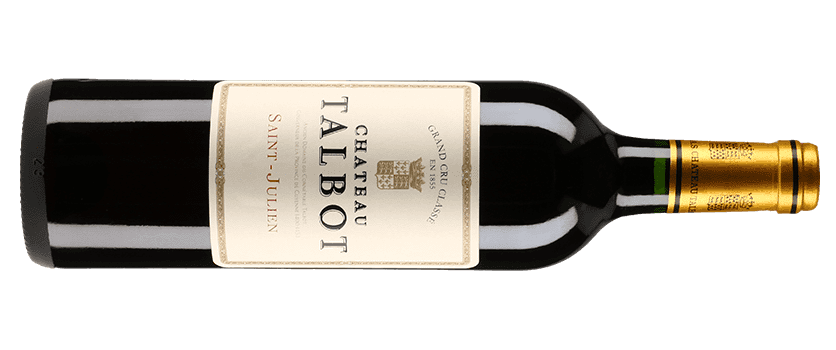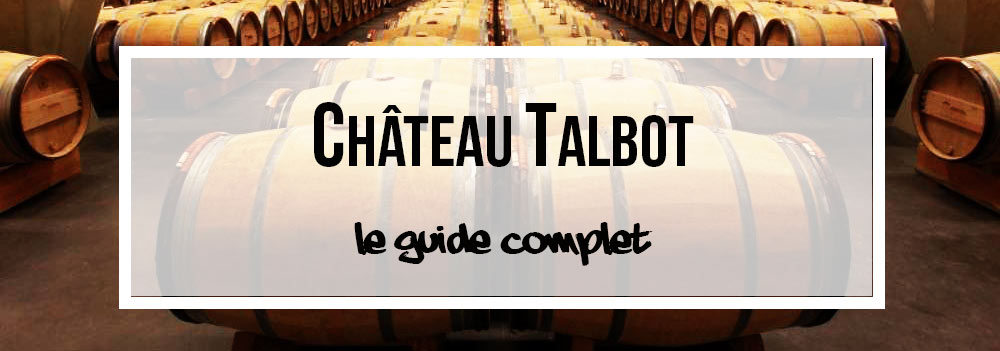Welcome to our Château Talbot guide. Discover the history, essential information about the Talbot wineas well as the finest vintages.
Order Château Talbot grands online
Chateau Talbot | Overview and history
Visit Château Talbot takes its name from a former British soldier, Connetable Talbot. In 1453, he was killed at the Battle of Castillon, and the estate was named in his honor. Several hundred years later, it remained in the hands of the d'Aux-Lally family until 1917, when the Cordier family purchased the property. The Cordier family were well known in Bordeaux as négociants and, for decades, were responsible for all wine distribution. This is no longer the case, as the wines are now sold openly in Bordeaux to a wide variety of négociants. The Cordier family also owned another well-known estate in Saint-Julien, Château Gruaud Laroseas well as other vineyards, including Château Senejac, in the Haut-Médoc appellation.
-
Château Talbot today
Lorraine Cordier and Nancy Bignon-Cordier, daughters of Jean Cordier, own and manage Château Talbot today. In recent years, the family has invested in improving the quality of its Left Bank wines, vineyards, winemaking facilities and winery. Wanting to take advantage of every opportunity to make the most of their Talbot terroir, they have two consultants: Stéphane Derenoncourt and Jacques Boissenot. To enhance the estate's potential, they have also completely renovated their cellars, winemaking facilities, wine cellars and barrel cellars. The improvement is visible in the cellar's angular, modern and architectural design, with its handles all shaped like the letter T, as well as in the enhanced quality of the wines coming from Château Talbot today. In 2007, Talbot changed direction with the aim of improving its wine. One of their first decisions was to hire Stéphane Derenoncourt as a consultant. Before working with Stéphane Derenoncourt, Talbot used to place the berries in a tunnel after picking, blowing hot air to remove excess moisture. This practice is no longer used today. Another change was to pick fruit at a higher degree of ripeness, while increasing sorting levels and reducing yields. Château Talbot has also begun experimenting with the Genodics system in their Médoc vineyards. The Genodics system emits various sounds and frequencies to enhance or limit protein growth in the vine.
The hope is that the different levels of frequency will reduce or eliminate the ability of parasites and diseases to develop. At the end of 2017, after the harvest, Jean-Michel Laporte was appointed estate manager, a position he previously held at Château La Conseillante in Pomerol.
-
Chateau Talbot | Vineyard, Terroir, Grape varieties
Château Talbot's 102-hectare vineyard is made up of 66% of Cabernet Sauvignon , 26% of Merlot , 5% of Petit Verdot and 3% of Cabernet Franc . This shows a decrease in the amount of Cabernet Sauvignon that was planted in the vineyard in the mid-1990s. With 102 hectares of vines, Château Talbot boasts one of the largest vineyards in the Médoc and, even more interestingly, makes Talbot a candidate for the largest vineyard on the Left Bank, which is located in a single block of vines. Although their vineyard takes a few twists, turns and angles, here and there, it is truly one vast lot of vines. They have good neighbors, their vineyards adjoining vines from Château Léoville Las Cases, Léoville Barton and Léoville Poyferre. Château Talbot also occupies the highest elevations in the Saint Julien appellation, at 23 meters above sea level. The terroir consists mainly of gravel, sand and clay soils, overlain by sandstone, clay, sand and iron just below the surface. There is also a small parcel of land of around 5 hectares dedicated to the production of Bordeaux white wine from Sauvignon Blanc and Semillon plantations. The white wine vines are planted with 80% of Sauvignon Blanc and 20% of Semillon in a cooler terroir that contains much more clay. The red wine vines are on average around thirty years old. The vineyard is planted at a density of 7,700 vines per hectare.
-
Wine-making
To produce Château Talbot red wine, the wine is vinified in a combination of large, truncated, temperature-controlled wooden vats and stainless steel tanks.
Stainless steel tanks are only used for young vines. Château Talbot wine is then aged in new French oak barrels, 50% to 60%, for an average of 14 to 16 months. On average, Grand Vin production is around 25,000 cases of Château Talbot per year.
Ranking of Château Talbot's best vintages
Visit best vintages of Château Talbot are :
19822010, 2009, 2005, 1986, 2018, 2017, 2016, 2015 and 1961.
Old vintages of Château Talbot are said to have a great capacity for aging. A sure bet when looking for vintages for cellar placement, or even for your tastings of old Bordeaux vintages.





![✨ Comptoir des Millésimes honors Champagne's great winemakers ✨[LINK TO THE ORGANIC CELLAR]We've selected 11 exceptional estates that reveal the full richness of Champagne terroir through unique, refined cuvées. Hugues Godmé - In Verzenay, this family-run biodynamic estate offers precise, vibrant champagnes with a beautiful mineral tension.Egly-Ouriet - A benchmark for the Montagne de Reims, its powerful champagnes, aged for long periods in barrel, impress with their complexity.Moussé Fils - In Cuisles, the Meunier grape is king. Pertois-Moriset - Pure, taut Chardonnay Grands Crus for lovers of chalky finesse. A fine address in Mesnil-sur-Oger.Geoffroy - In Aÿ, this domaine produces fine champagnes, carefully crafted and barrel-aged to reveal the full complexity of the terroir.Larmandier-Bernier - Biodynamic viticulture, exceptional parcels and purity. Crystal-clear, intense champagnes for connoisseurs.Roger Coulon - Eight generations of expertise at Vrigny. Balanced, subtle and elegant champagnes.A. Bergère - In Avize, a dynamic house offering expressive, fruity and accessible cuvées.Adrien Renoir - A promising talent from Verzy, he produces fine, complex champagnes with a true sense of terroir.De Sousa - Emblematic house in Avize. Richness, depth, long ageing: Chardonnay at its peak.Pierre Paillard - In Bouzy, the family magnifies Pinot Noir with vinous, racy and sincere cuvées.📦 Order now on our website#ComptoirdesMillésimes #Champagne #VigneronsIndépendants #GrandVin #ChampagnesdeTerroir #LivraisonRapide](https://www.comptoirdesmillesimes.com/blog/wp-content/plugins/instagram-feed/img/placeholder.png)